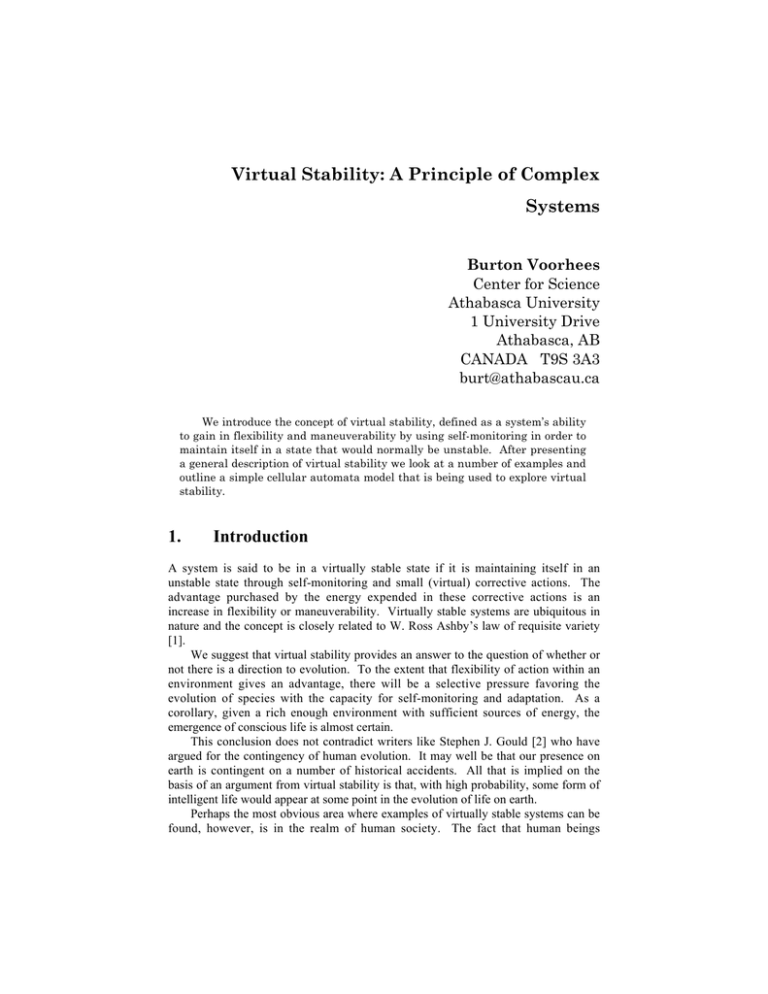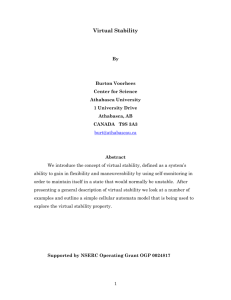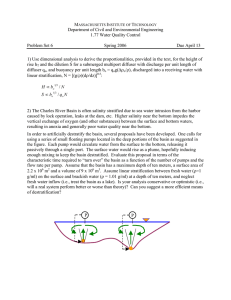Virtual Stability: A Principle of Complex Systems
advertisement

Virtual Stability: A Principle of Complex Systems Burton Voorhees Center for Science Athabasca University 1 University Drive Athabasca, AB CANADA T9S 3A3 burt@athabascau.ca We introduce the concept of virtual stability, defined as a system’s ability to gain in flexibility and maneuverability by using self-monitoring in order to maintain itself in a state that would normally be unstable. After presenting a general description of virtual stability we look at a number of examples and outline a simple cellular automata model that is being used to explore virtual stability. 1. Introduction A system is said to be in a virtually stable state if it is maintaining itself in an unstable state through self-monitoring and small (virtual) corrective actions. The advantage purchased by the energy expended in these corrective actions is an increase in flexibility or maneuverability. Virtually stable systems are ubiquitous in nature and the concept is closely related to W. Ross Ashby’s law of requisite variety [1]. We suggest that virtual stability provides an answer to the question of whether or not there is a direction to evolution. To the extent that flexibility of action within an environment gives an advantage, there will be a selective pressure favoring the evolution of species with the capacity for self-monitoring and adaptation. As a corollary, given a rich enough environment with sufficient sources of energy, the emergence of conscious life is almost certain. This conclusion does not contradict writers like Stephen J. Gould [2] who have argued for the contingency of human evolution. It may well be that our presence on earth is contingent on a number of historical accidents. All that is implied on the basis of an argument from virtual stability is that, with high probability, some form of intelligent life would appear at some point in the evolution of life on earth. Perhaps the most obvious area where examples of virtually stable systems can be found, however, is in the realm of human society. The fact that human beings consciously monitor their behavior, and can keep different course of action in mind without making an immediate commitment to any of them, is a prime example of the capacity to maintain virtually stable states. 2. Examples 2.1 Standing A simple example of virtual stability is a person standing. The upright position is maintained by feedback circuits in the vestibular system, connected to our kinesthetic sense of body position and to muscle groups in the legs and feet that make the small adjustments necessary to maintain the standing position. In a recent conference presentation, Bach-y-Rita [3] describes a sensory substitution experiment in which a woman with neurological damage affecting her vestibular system was unable to stand until she was provided with a special hat containing accelerometers and motion sensors that would provide a tactile signal whenever her head began to move away from the vertical. With this assistance, she was able to consciously control her body posture while standing and walking, something that is automatic for most of us. The flexibility we gain from the fact that standing is a virtually stable state is the ability to move quickly in any direction. There are even degrees of flexibility. This shows up, for example, in boxing, in the distinction between the stalkers, who plant their feet firmly on the floor, and the dancers who, in the words of Mohammed Ali, “float like a butterfly, sting like a bee”. Of course, for most of us, standing does not seem to be an unstable state. It has become automated to the point that we only notice the instability when something such as alcohol interfere with the control systems involved. 2.2 Aircraft Design In the early 1980’s, the United States Air force was testing an experimental fighter called the X-29. The unusual feature of this aircraft was that its wings were swept forward rather than back. This configuration is aerodynamically unstable so the plane required a triply redundant computer monitoring system that checked the plane’s motion 40 times per second and made the control adjustments necessary to keep it on course. If this system were to fail for even one-quarter of a second, the X29 would have tumbled out of control. The advantage gained was maneuverability. While an ordinary fighter with swept-back wings requires energy to change course, the X-29 would simply “fall” in the direction indicated. Although this particular plane was never produced, aircraft designers are well aware of the trade-off between stability and maneuverability. Fighter planes today are, by design, very close to being unstable, while passenger planes are designed for stability. 2.3 Conversational Positioning Feminist theorists and social psychologists that follow the social constructionist point-of-view, consider many apparently ordinary conversations as power struggles based on the idea of “positioning”. The idea is that each party to the conversation is consciously or unconsciously attempting to position themselves favorably with respect to the others in the moral universe defined by the elements of discourse that are in play. As described by Burr [4], “in any interchange between people, there is a constant monitoring of the ‘definition of the situation’ that each participant is struggling to bring off”. Each player in this game can choose to accept a “position” that is offered them, or to resist it. The statement “you’ve really been taken advantage of,” for example, offers the person it is addressed to the role of victim and places the person making the statement in the superior position of sympathetic friend or advisor. A response of “Yes, it’s really been tough” accepts this position while a reply like “No, I’ve got everything under control,” resists it. Within such a situation, it is important to be aware of the continuing interplay in order to avoid placing others into unintended, undesirable positions, and also being placed in such positions by others. In such rhetorical battles of wit the advantage goes to the person who is best able to maintain him/herself in the unstable state of having no position, or at least a very flexible position, until the opportunity arises to seize the high ground. Keeping one’s options open is an important aspect of many forms of social behavior. 2.4 Mate Selection In sociobiology, male and female sexual strategies are explained in terms of the attempt to maximize the transmission of genetic material to the next generation. Thus, males are seen as being genetically programmed to seek multiple sex partners, while a female seeks to keep a man sexually dependent so that he will stay and provide for her children. Be this as it may, we can consider mate selection strategies in a monogamous culture. One strategy is to marry the first available person. This leads to stability in one’s sex life, a stability that is reinforced by the bonds of romantic love. Such stability is very helpful in allowing a person, male or female, to “get on with the rest of their life,” but it may also end up locking a person into an ultimately destructive relationship. Another strategy is to experiment, to “play the field,” and maintain a number of relationships until a choice of permanent mate can be made on a basis of compatibility and affection. Following this strategy requires self-monitoring and emotional control in order to avoid obsessive attachments. It is, in this sense, unstable, but it also provides a better chance over the long run of finding a more suitable mate. 2.5 Global Finance The behavior of money managers in the emerging global economy provides an economic example of the advantage conferred by virtual stability. Thomas L. Friedman describes the behavior of these individuals in his book, The Lexus and the Olive Tree [5], which provides many examples that can be understood in terms of virtual stability. The most obvious is the fact that the rapid availability of information about world financial markets means that money managers must have the flexibility to rapidly move capitol from one market to another, a state that would be highly unstable without the continual monitoring of the performance of their investments. The other side of this is that money can move in and out of a national economy so quickly that any minor instability in that economy can be greatly magnified if the national government is not also engaged in high frequency selfmonitoring. 3. Models of Virtual Stability Simple one-dimensional cellular automata can be used to construct model systems that display virtually stable behavior. One such model is currently being developed. It is based on a binary rule defined on a six-site lattice with periodic boundary conditions. The rule table is 00 01 10 11 0 1 1 0 (This is Rule 102 in the usual labeling convention.) This rule has four basins of attraction, which will be labeled A, B, C, and D. To model a virtually stable system based on a CA rule three discrete time scales are employed. Iterations of the CA rule itself take place on the intermediate scale. The fast scale is used to introduce fluctuations, and the slow scale corresponds to the control function that specifies which basin the system is to be in at any given (slow scale) time. The basin labeled D is called death. For the simplest case, the control function will be defined by a sequence that specifies either basin A or basin B at each (slow scale) time step. The initial conditions will specify the control sequence, an initial state in the required basin (say A for definiteness), and set the values of three integer functions, c, m, and k to zero. The value of m will count the number of iterations of the CA rule, and when m = M a slow scale time step is taken, possibly introducing a new target basin. The value of k counts the number of slow scale time steps and when k = K the system stops and prints the accumulated value of c, which is a cost function. The CA rule operates on the initial state, producing a new state that is still in the target basin for k = 0, and an integer function n is set to 0. The value of n counts the number of fast scale time steps. The system state is now subjected to a perturbation based a probability matrix. The entries in this matrix are what determine the stability or instability of the system. For this first case, the probability of an A C or B C transition is set to 0. There is a small but positive probability, however, for the A D and B D transitions (i.e., there is always a small chance the system will die). If one of these transitions occurs, the program stops and prints out m, k and dead. Whether the system itself is stable or unstable depends on the A B and B A transition probabilities. If the A B probabilities are small while A A and B B are large the system is relatively stable, while if the A A and B B probabilities are small while the A B probabilities are large, then the system is unstable. The perturbed state is first tested to see if it is in basin D. If not, it is tested to see if it has remained in the specified target basin (e.g. A). If so, n is incremented by one and the state is perturbed again and tested again. If a transition to the other basin (e.g., B) has occurred, then it is necessary to return the state to the target basin. There is a cost associated to this. The return is carried out through use of the same probability matrix as before. A loop is established in which the state is perturbed and tested until a state in the target is achieved. The cost of this return is equal to the number of cycles through the loop. At this point, n is increased by one and the system reenters the fast time scale process of perturbation and testing until n = N and another CA step is taken. At the end, assuming that the system has not died, the total accumulated cost is printed. For stable systems the probability of a perturbation out of the target basin is small, but once it occurs, the cost of a return is likely to be high. For unstable systems, on the other hand, there is a high probability of perturbation out of the target basin, but the cost of return will be low, modeling virtually stable states. By adjusting the transition probabilities a variety of different situations can be studied as a means of gaining some insight into the conditions under which a capacity for virtual stability provides an advantage. 4. Some General Considerations There are a number of aspects of complex systems that relate to the capacity to maintain, and the desirability of, virtually unstable states. One obvious parameter involved will be the frequency of self-monitoring. In maintaining a virtually stable state there is a trade-off between a small but ongoing energy expenditure and the advantage gained from the ability to change states quickly without excessive energy expenditure. Thus, the self-monitoring frequency must be high enough that corrective actions remain small and require minimal energy expenditure. This requires that this frequency be syntonized with the spectrum of external fluctuations that produce destabilizing effects. Too high a self-monitoring frequency and energy and attention become monopolized, too low and the system looses its virtual stability. Another factor involved is illustrated by the example of the X-29. This aircraft was so maneuverable that it was dangerous to the life of the pilot. In other words, it is possible for a system to be too flexible. Roughly stated Ashby’s law of requisite variety says that the variety of control possibilities must match the variety of the external disturbances if the outcome is to be uniquely controlled. Thus, the degree of flexibility required is no greater than what is sufficient to deal with the spectrum of ordinary environmental fluctuations, with a cut-off for very low probability events. The location of this cut-off itself becomes a question for theoretical investigation. The basic lesson of virtual stability is that life is not about stability, it is about managing instability so as to produce the illusion of stability. Acknowledgements Work on this paper has been supported by NSERC Operating Grant OGP 0024817 Biblography [1] W. Ross Ashby (1958) Requisite variety and its implications for the control of complex systems. Cybernetica 1, 83 – 99. [2] Stephen J. Gould (1989) Wonderful Life: The Burgess Shale and the Nature of History. NY: Norton. [3] Paul Bach-y-Rita (2002) Tactile-sensory substitution in blind subjects. Presented at Tucson 2002: Toward a Science of Consciousness, April 8 – 12, 2002. [4] Vivien Burr (1995) An Introduction to Social Constructionism. London: Routledge. p. 146. [5] Thomas L. Friedman (2000) The Lexus and the Olive Tree. NY: Anchor.







